
chitu
High-performance inference framework for large language models, focusing on efficiency, flexibility, and availability.
Stars: 1289
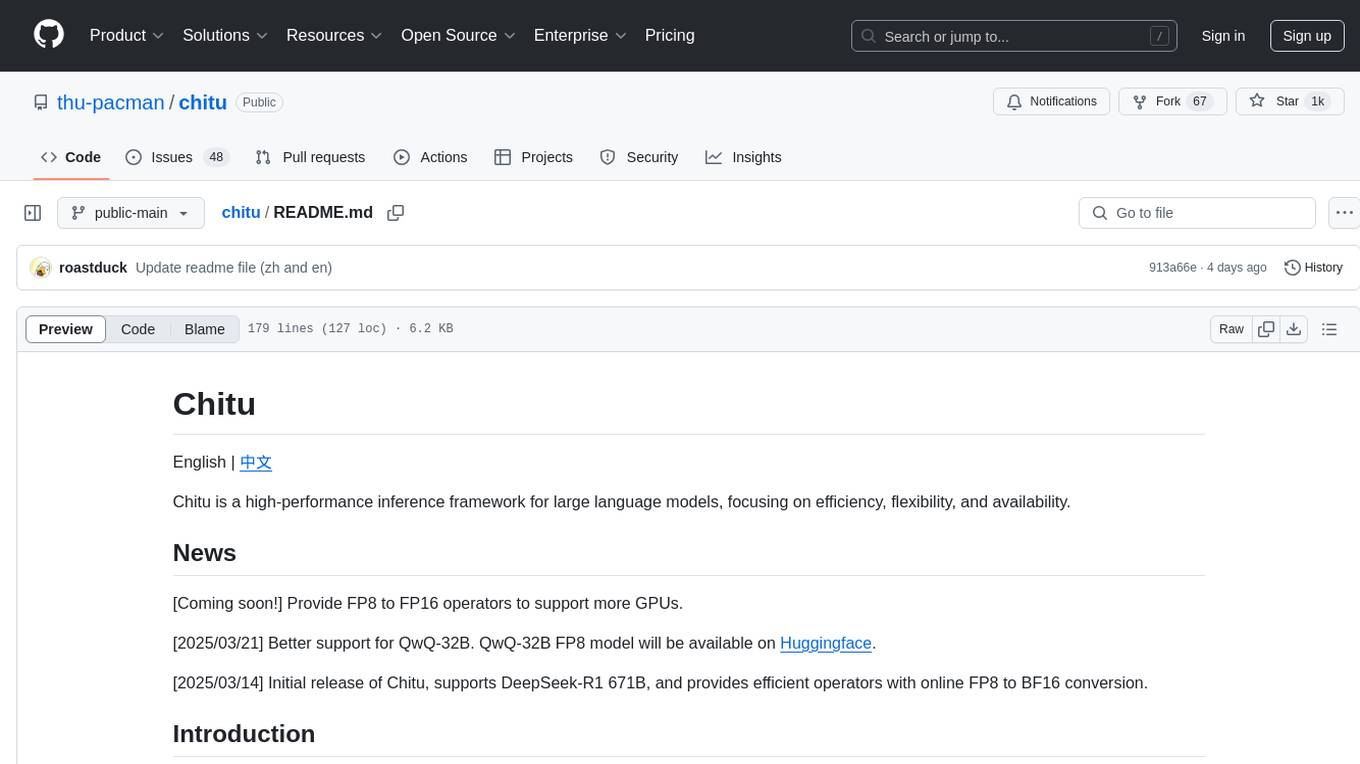
Chitu is a high-performance inference framework for large language models, focusing on efficiency, flexibility, and availability. It supports various mainstream large language models, including DeepSeek, LLaMA series, Mixtral, and more. Chitu integrates latest optimizations for large language models, provides efficient operators with online FP8 to BF16 conversion, and is deployed for real-world production. The framework is versatile, supporting various hardware environments beyond NVIDIA GPUs. Chitu aims to enhance output speed per unit computing power, especially in decoding processes dependent on memory bandwidth.
README:
中文 | English
Chitu「赤兔」是一个专注于效率、灵活性和可用性的高性能大模型推理框架。
- [2025/08/01] 发布 v0.4.0,大幅提升了一体机推理部署场景的性能和稳定性,适配昇腾、英伟达、沐曦、海光,支持 DeepSeek、Qwen、GLM、Kimi 等模型。
- [2025/07/28] 发布 v0.3.9,首发支持华为昇腾 910B 推理部署智谱 GLM-4.5 MoE 模型。
- [2025/06/12] 发布 v0.3.5,提供昇腾 910B 完整原生支持,提供 Qwen3 系列模型高性能推理方案。
- [2025/04/29] 发布 v0.3.0,新增 FP4 在线转 FP8、BF16 的高效算子实现,支持 DeepSeek-R1 671B 的 FP4 量化版。
- [2025/04/18] 发布 v0.2.2,新增 CPU+GPU 异构混合推理支持,实现单卡推理 DeepSeek-R1 671B。
- [2025/03/14] 发布 v0.1.0,支持 DeepSeek-R1 671B,提供 FP8 在线转 BF16 的高效算子实现。
赤兔定位于「生产级大模型推理引擎」,充分考虑企业 AI 落地从小规模试验到大规模部署的渐进式需求,专注于提供以下重要特性:
- 多元算力适配:不仅支持 NVIDIA 最新旗舰到旧款的多系列产品,也为国产芯片提供优化支持。
- 全场景可伸缩:从纯 CPU 部署、单 GPU 部署到大规模集群部署,赤兔引擎提供可扩展的解决方案。
- 长期稳定运行:可应用于实际生产环境,稳定性足以承载并发业务流量。
项目团队感谢广大用户及开源社区提出的宝贵意见和建议,并将持续改进赤兔推理引擎。 然而,受制于团队成员的精力,无法保证及时解决所有用户在使用中遇到问题。 如需专业技术服务,欢迎致信 [email protected]
性能数据与您的硬件配置、软件版本、测试负载相关,多次测试结果可能存在波动。
请参阅开发手册获取完整的安装使用说明。
对于在单机环境上快速验证的场景,建议使用官方镜像进行部署。目前提供适用于以下平台的镜像:
- 昇腾:qingcheng-ai-cn-beijing.cr.volces.com/public/chitu-ascend:latest
- 英伟达:qingcheng-ai-cn-beijing.cr.volces.com/public/chitu-nvidia:latest
- 沐曦:qingcheng-ai-cn-beijing.cr.volces.com/public/chitu-muxi:latest
更多模型请参见 支持的模型。
赤兔项目欢迎开源社区的朋友们参与项目共建,请参阅贡献指南。
如果您有任何问题或疑虑,欢迎提交issue。
您也可以扫码加入赤兔交流微信群:
本项目采用 Apache License v2.0 许可证 - 详见 LICENSE 文件。
本代码仓库还引用了一些来自其他开源项目的代码片段,相关版权信息已在代码中以 SPDX 格式标注。这些代码片段的许可证信息可以在 LICENSES/ 目录下找到。
本代码仓库还包含遵循其他开源许可证的第三方子模块。您可以在 third_party/ 目录下找到这些子模块,该目录中包含了它们各自的许可证文件。
非常感谢来自华为、沐曦、海光、燧原、智谱、中国电信、并行科技等各方的帮助。
在构建 Chitu 的过程中,我们从以下项目(按字母排序)中学到了很多,并复用了一些函数:
我们将持续为开源社区贡献更高效、更灵活、更兼容、更稳定的大模型推理部署解决方案。
For Tasks:
Click tags to check more tools for each tasksFor Jobs:
Alternative AI tools for chitu
Similar Open Source Tools

chitu
Chitu is a high-performance inference framework for large language models, focusing on efficiency, flexibility, and availability. It supports various mainstream large language models, including DeepSeek, LLaMA series, Mixtral, and more. Chitu integrates latest optimizations for large language models, provides efficient operators with online FP8 to BF16 conversion, and is deployed for real-world production. The framework is versatile, supporting various hardware environments beyond NVIDIA GPUs. Chitu aims to enhance output speed per unit computing power, especially in decoding processes dependent on memory bandwidth.

AI_Gen_Novel
AI_Gen_Novel is a project exploring the limits of AI in writing online fiction. Leveraging large language models and multi-agent technology, the tool aims to automatically generate web novels by compressing long texts, optimizing prompts, and enhancing originality. The tool combines the core idea of RecurrentGPT with language-based iterative computation to create texts of any length. Future directions include enhancing model capabilities, optimizing program architecture, and introducing more prior knowledge for structured storytelling.

HTFramework
HTFramework is a rapid development framework based on Unity, integrating modular requirements, code reusability, practicality, high cohesion, unified coding standards, extensibility, maintainability, generality, and pluggability. It provides continuous maintenance and upgrades. The framework includes modules for aspect-oriented program code tracking, audio management, controller simplification, coroutine scheduling, custom modules, custom datasets, debugging, entity-component-system, entity management, event handling, exception handling, finite state machines, hotfixing, input management, instruction system, main module access, network client, object pooling, procedures, reference pooling, resource loading, step editing, task editing, UI management, utility tools, web requests, and optional AI, ILRuntime-based hotfixing, XLua integration, and game component modules.
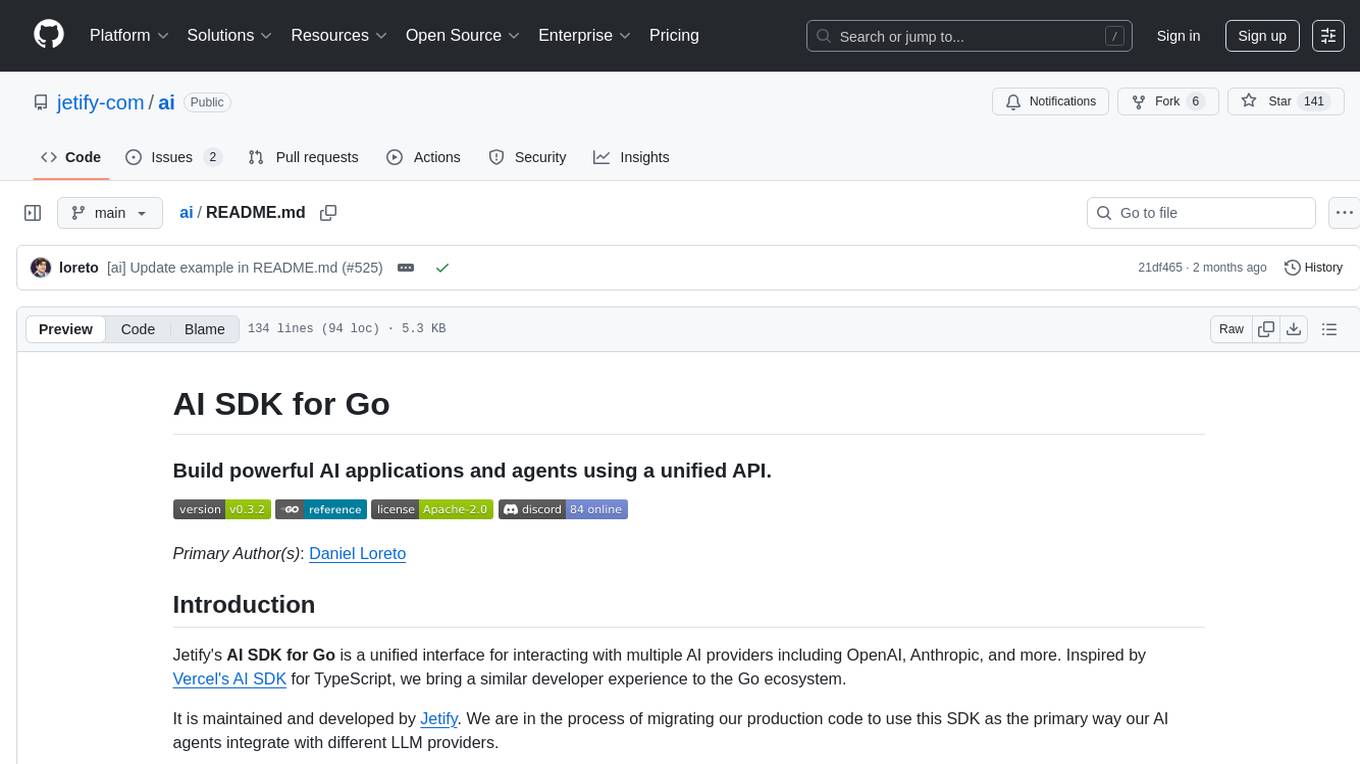
ai
Jetify's AI SDK for Go is a unified interface for interacting with multiple AI providers including OpenAI, Anthropic, and more. It addresses the challenges of fragmented ecosystems, vendor lock-in, poor Go developer experience, and complex multi-modal handling by providing a unified interface, Go-first design, production-ready features, multi-modal support, and extensible architecture. The SDK supports language models, embeddings, image generation, multi-provider support, multi-modal inputs, tool calling, and structured outputs.
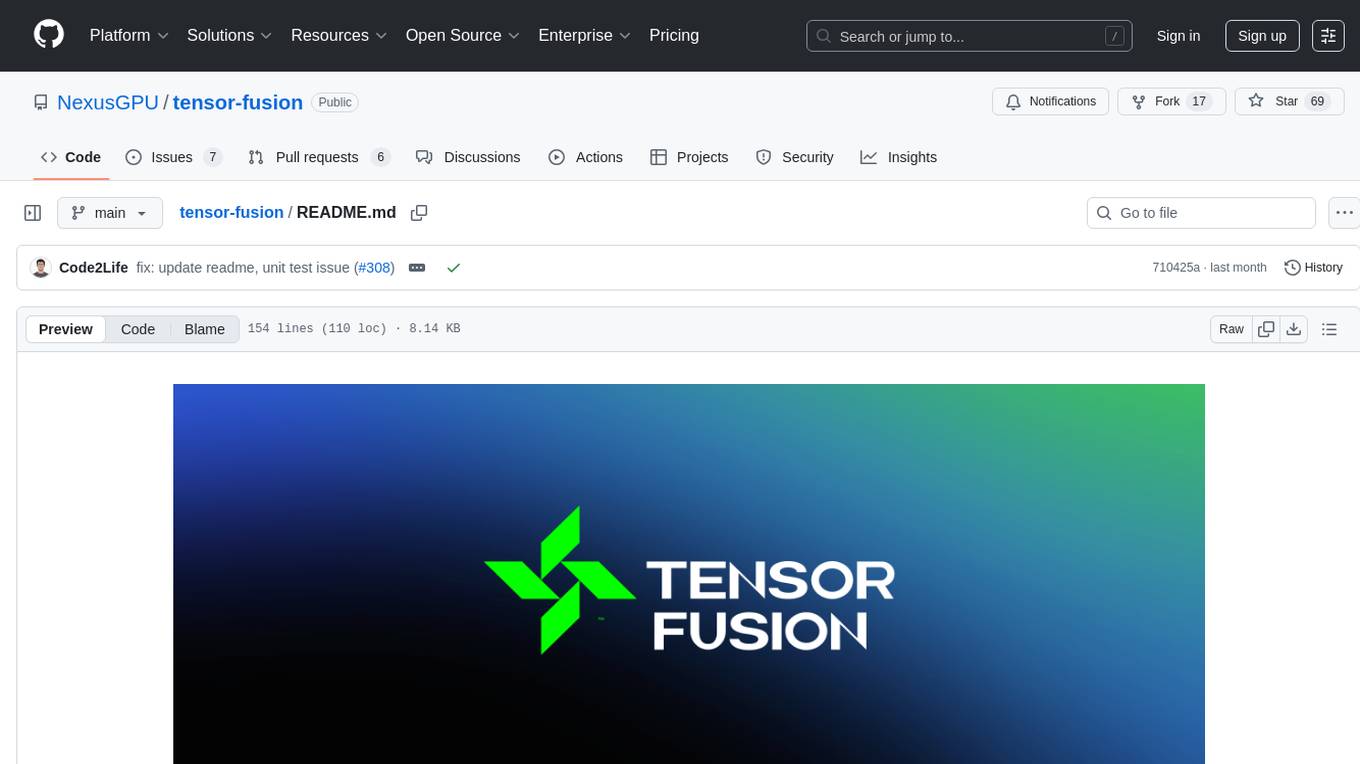
tensor-fusion
Tensor Fusion is a state-of-the-art GPU virtualization and pooling solution designed to optimize GPU cluster utilization. It offers features like fractional virtual GPU, remote GPU sharing, GPU-first scheduling, GPU oversubscription, GPU pooling, monitoring, live migration, and more. The tool aims to enhance GPU utilization efficiency and streamline AI infrastructure management for organizations.

GTA5-Stand-LuaAIO
GTA5-Stand-LuaAIO is a comprehensive Lua script for Grand Theft Auto V that enhances gameplay by providing various features and functionalities. It is designed to streamline the gaming experience and offer players a wide range of customization options. The script includes features such as vehicle spawning, teleportation, weather control, and more, making it a versatile tool for GTA V players looking to enhance their gameplay.
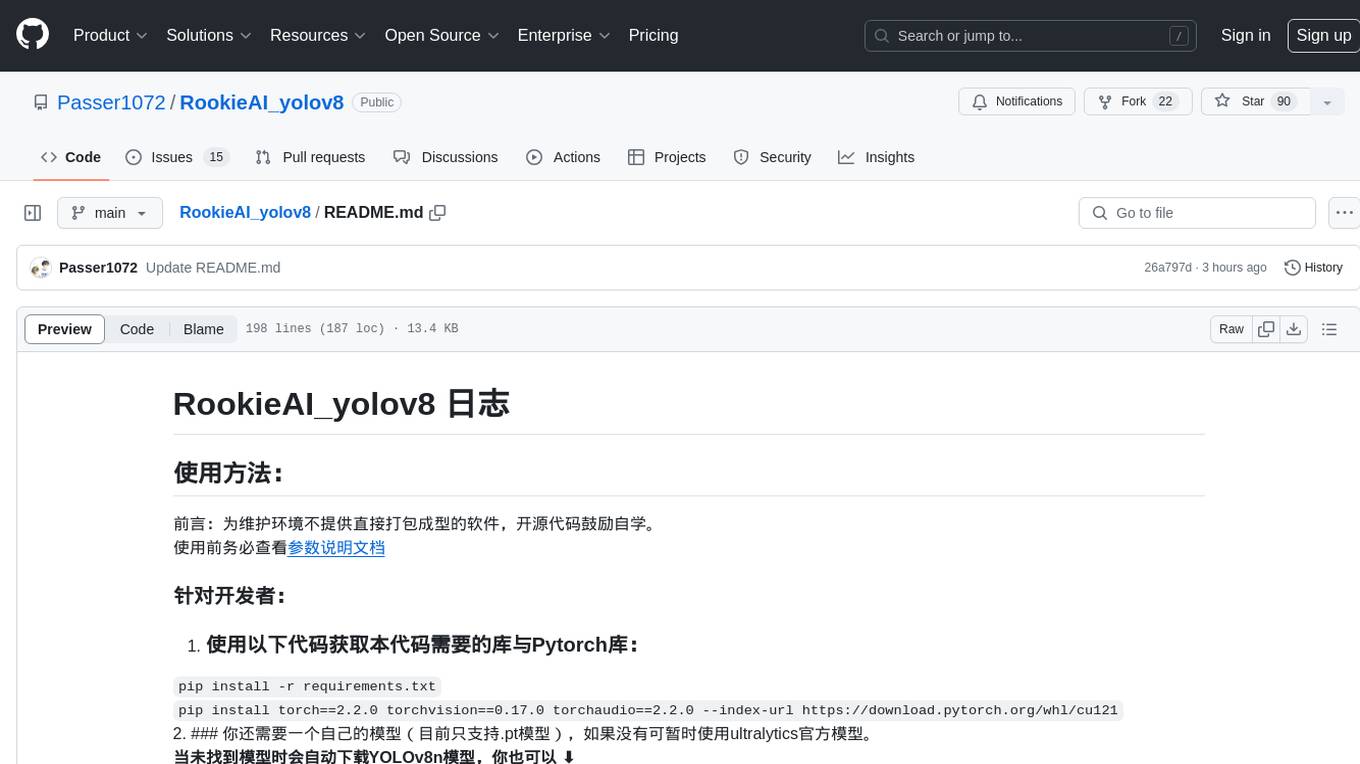
RookieAI_yolov8
RookieAI_yolov8 is an open-source project designed for developers and users interested in utilizing YOLOv8 models for object detection tasks. The project provides instructions for setting up the required libraries and Pytorch, as well as guidance on using custom or official YOLOv8 models. Users can easily train their own models and integrate them with the software. The tool offers features for packaging the code, managing model files, and organizing the necessary resources for running the software. It also includes updates and optimizations for better performance and functionality, with a focus on FPS game aimbot functionalities. The project aims to provide a comprehensive solution for object detection tasks using YOLOv8 models.
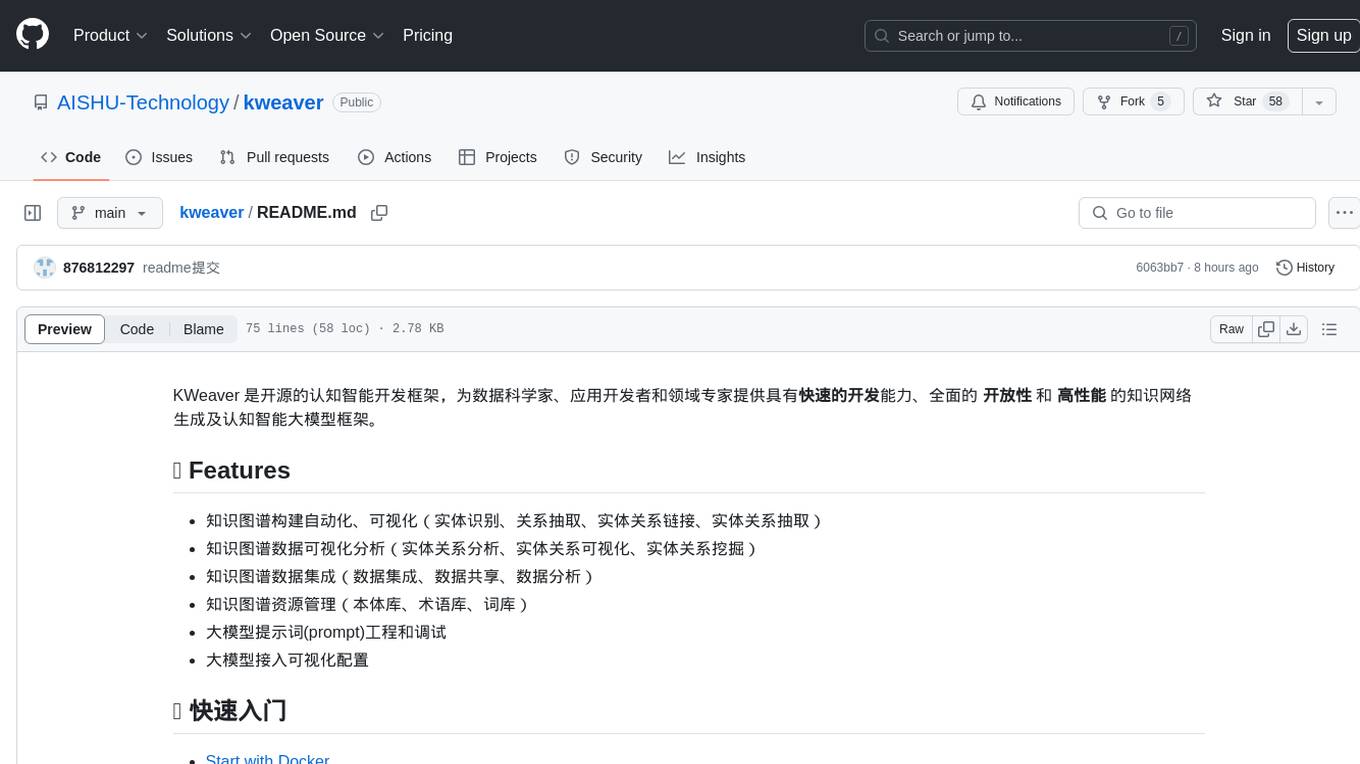
kweaver
KWeaver is an open-source cognitive intelligence development framework that provides data scientists, application developers, and domain experts with the ability for rapid development, comprehensive openness, and high-performance knowledge network generation and cognitive intelligence large model framework. It offers features such as automated and visual knowledge graph construction, visualization and analysis of knowledge graph data, knowledge graph integration, knowledge graph resource management, large model prompt engineering and debugging, and visual configuration for large model access.
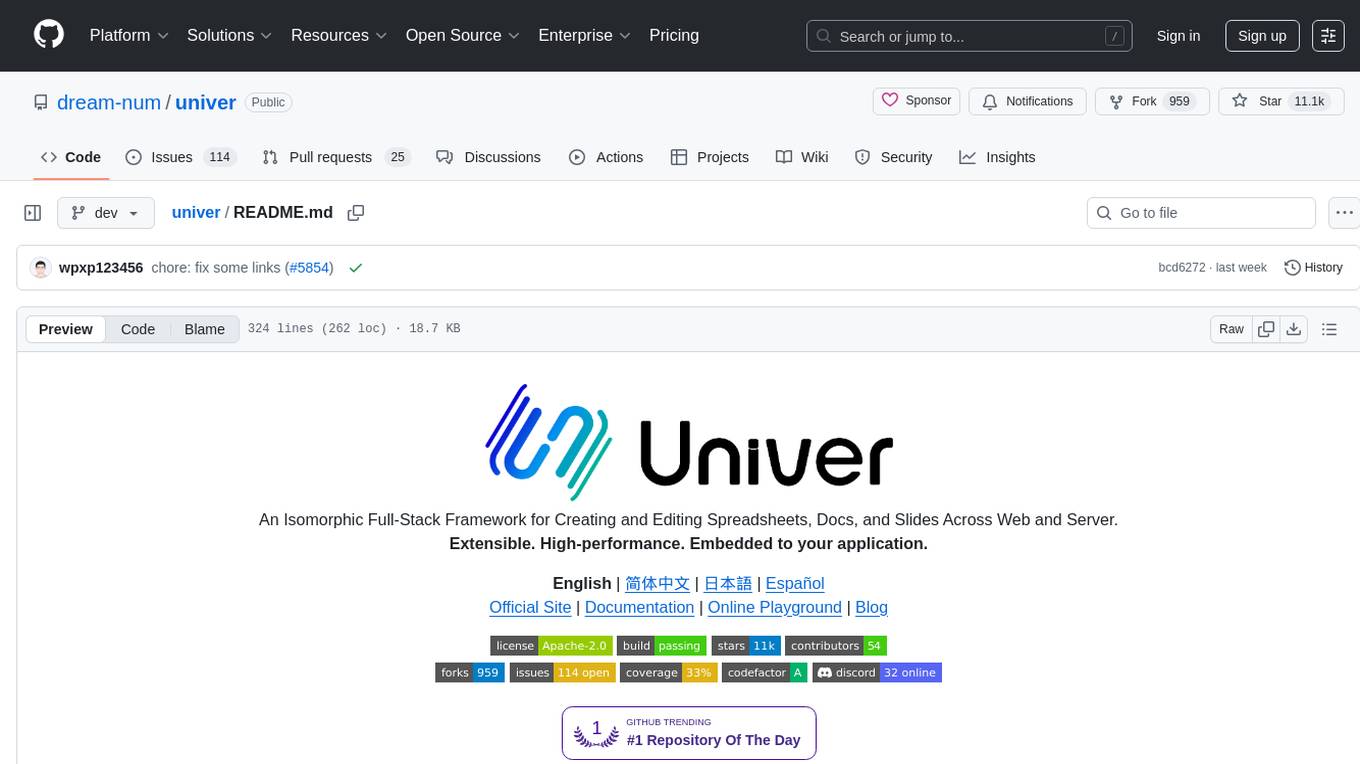
univer
Univer is an isomorphic full-stack framework designed for creating and editing spreadsheets, documents, and slides across web and server. It is highly extensible, high-performance, and can be embedded into applications. Univer offers a wide range of features including formulas, conditional formatting, data validation, collaborative editing, printing, import & export, and more. It supports multiple languages and provides a distraction-free editing experience with a clean interface. Univer is suitable for data analysts, software developers, project managers, content creators, and educators.
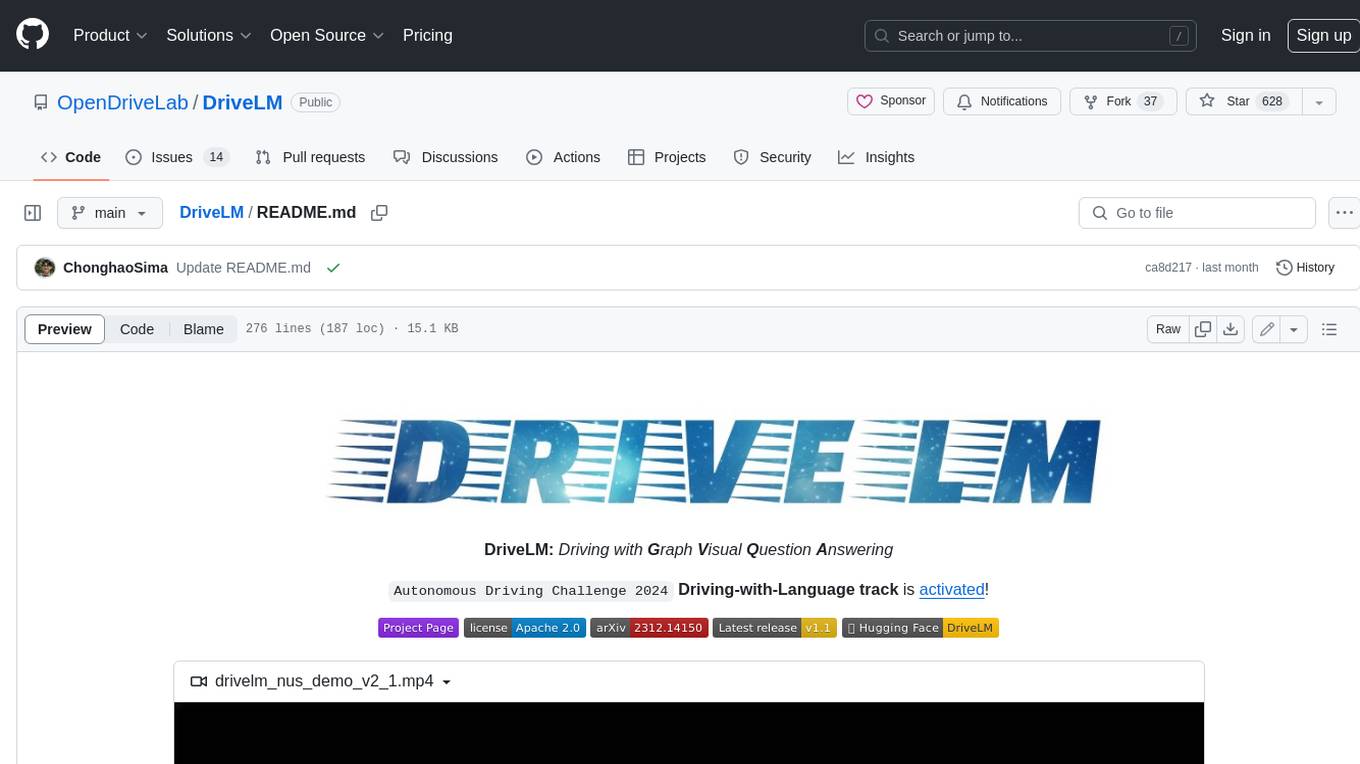
DriveLM
DriveLM is a multimodal AI model that enables autonomous driving by combining computer vision and natural language processing. It is designed to understand and respond to complex driving scenarios using visual and textual information. DriveLM can perform various tasks related to driving, such as object detection, lane keeping, and decision-making. It is trained on a massive dataset of images and text, which allows it to learn the relationships between visual cues and driving actions. DriveLM is a powerful tool that can help to improve the safety and efficiency of autonomous vehicles.

RepoMaster
RepoMaster is an AI agent that leverages GitHub repositories to solve complex real-world tasks. It transforms how coding tasks are solved by automatically finding the right GitHub tools and making them work together seamlessly. Users can describe their tasks, and RepoMaster's AI analysis leads to auto discovery and smart execution, resulting in perfect outcomes. The tool provides a web interface for beginners and a command-line interface for advanced users, along with specialized agents for deep search, general assistance, and repository tasks.
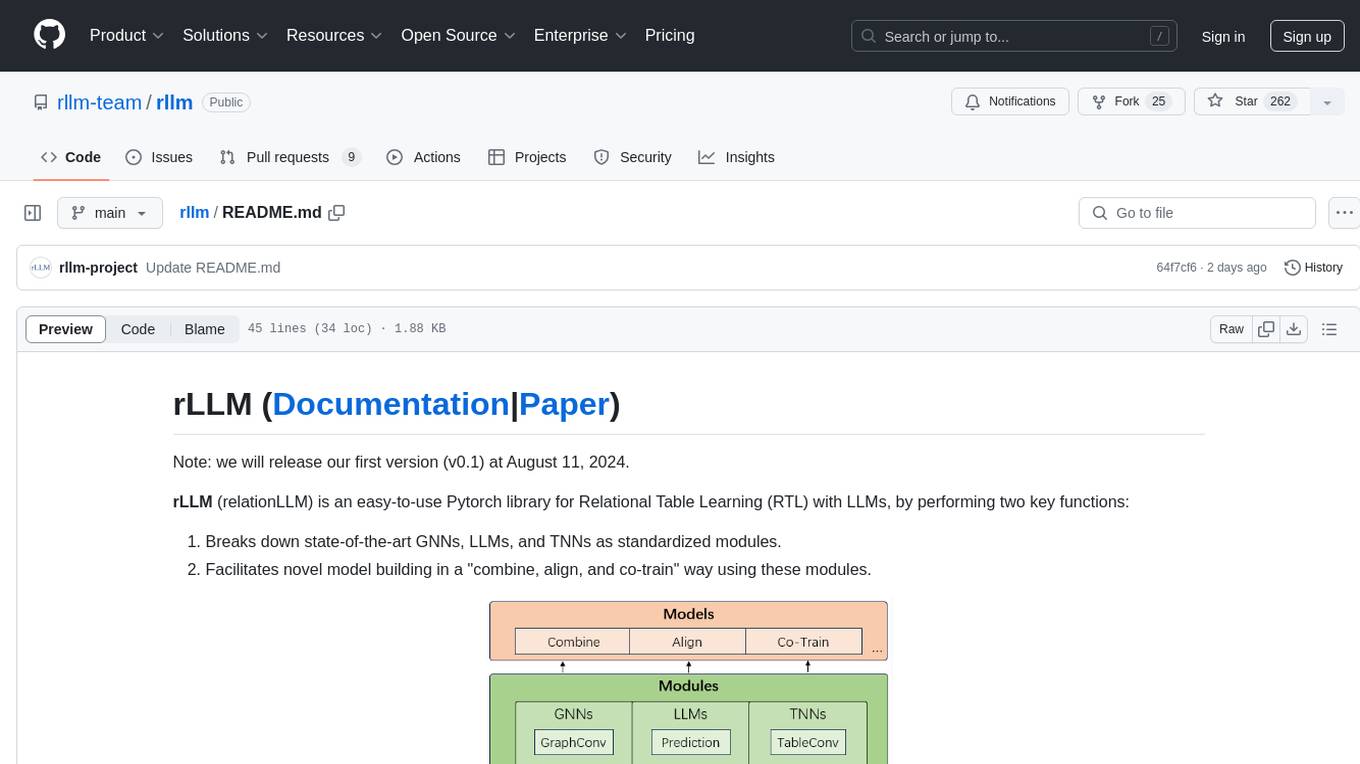
rllm
rLLM (relationLLM) is a Pytorch library for Relational Table Learning (RTL) with LLMs. It breaks down state-of-the-art GNNs, LLMs, and TNNs as standardized modules and facilitates novel model building in a 'combine, align, and co-train' way using these modules. The library is LLM-friendly, processes various graphs as multiple tables linked by foreign keys, introduces new relational table datasets, and is supported by students and teachers from Shanghai Jiao Tong University and Tsinghua University.
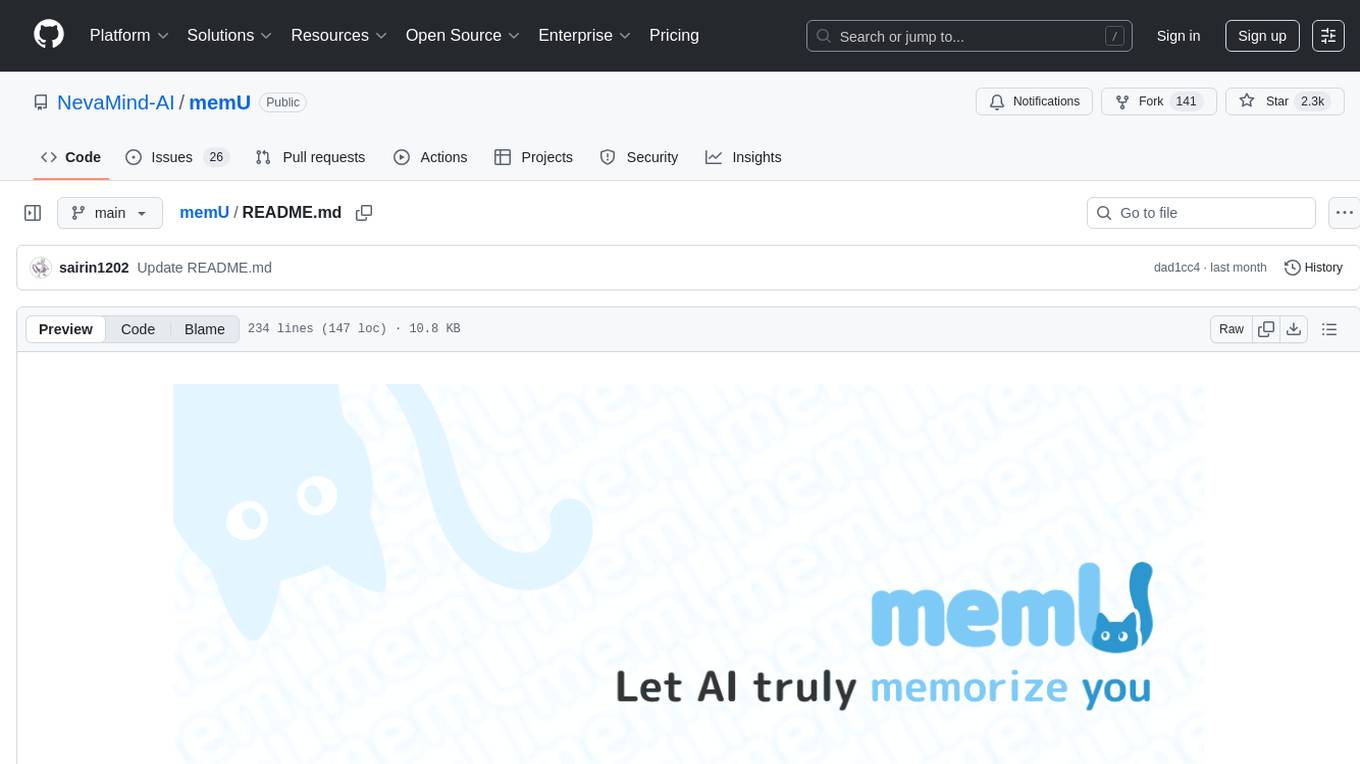
memU
MemU is an open-source memory framework designed for AI companions, offering high accuracy, fast retrieval, and cost-effectiveness. It serves as an intelligent 'memory folder' that adapts to various AI companion scenarios. With MemU, users can create AI companions that remember them, learn their preferences, and evolve through interactions. The framework provides advanced retrieval strategies, 24/7 support, and is specialized for AI companions. MemU offers cloud, enterprise, and self-hosting options, with features like memory organization, interconnected knowledge graph, continuous self-improvement, and adaptive forgetting mechanism. It boasts high memory accuracy, fast retrieval, and low cost, making it suitable for building intelligent agents with persistent memory capabilities.

AgC
AgC is an open-core platform designed for deploying, running, and orchestrating AI agents at scale. It treats agents as first-class compute units, providing a modular, observable, cloud-neutral, and production-ready environment. Open Agentic Compute empowers developers and organizations to run agents like cloud-native workloads without lock-in.

AIO
AIO is a comprehensive guide for setting up a home All-in-One server, enabling users to create an enterprise-level virtualized environment at home. It allows running multiple operating systems simultaneously, achieving public network access, optimizing hardware performance, and reducing IT costs. The guide includes detailed documentation for setting up from scratch and requires a computer with virtualization support, VMware ESXi installation media, and basic network configuration knowledge.

jan
Jan is an open-source ChatGPT alternative that runs 100% offline on your computer. It supports universal architectures, including Nvidia GPUs, Apple M-series, Apple Intel, Linux Debian, and Windows x64. Jan is currently in development, so expect breaking changes and bugs. It is lightweight and embeddable, and can be used on its own within your own projects.
For similar tasks
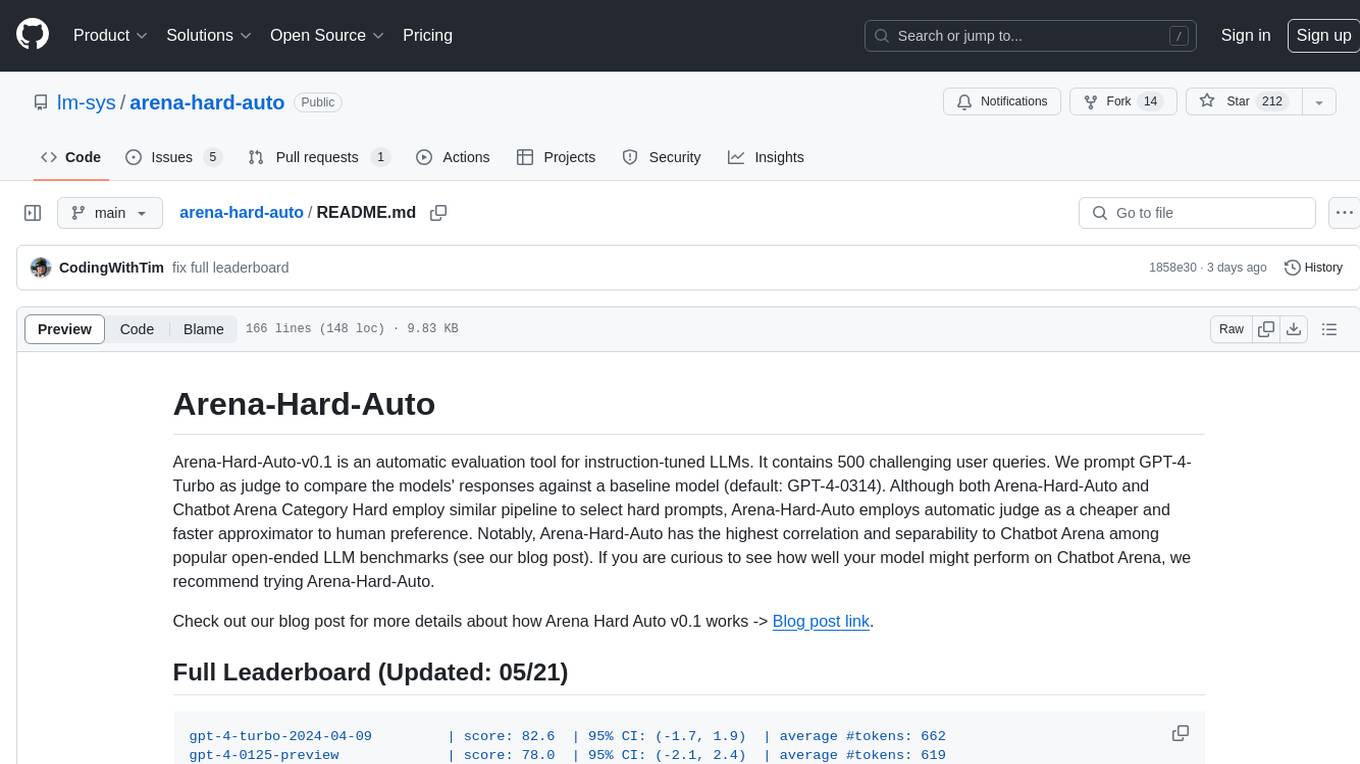
arena-hard-auto
Arena-Hard-Auto-v0.1 is an automatic evaluation tool for instruction-tuned LLMs. It contains 500 challenging user queries. The tool prompts GPT-4-Turbo as a judge to compare models' responses against a baseline model (default: GPT-4-0314). Arena-Hard-Auto employs an automatic judge as a cheaper and faster approximator to human preference. It has the highest correlation and separability to Chatbot Arena among popular open-ended LLM benchmarks. Users can evaluate their models' performance on Chatbot Arena by using Arena-Hard-Auto.

max
The Modular Accelerated Xecution (MAX) platform is an integrated suite of AI libraries, tools, and technologies that unifies commonly fragmented AI deployment workflows. MAX accelerates time to market for the latest innovations by giving AI developers a single toolchain that unlocks full programmability, unparalleled performance, and seamless hardware portability.

ai-hub
AI Hub Project aims to continuously test and evaluate mainstream large language models, while accumulating and managing various effective model invocation prompts. It has integrated all mainstream large language models in China, including OpenAI GPT-4 Turbo, Baidu ERNIE-Bot-4, Tencent ChatPro, MiniMax abab5.5-chat, and more. The project plans to continuously track, integrate, and evaluate new models. Users can access the models through REST services or Java code integration. The project also provides a testing suite for translation, coding, and benchmark testing.
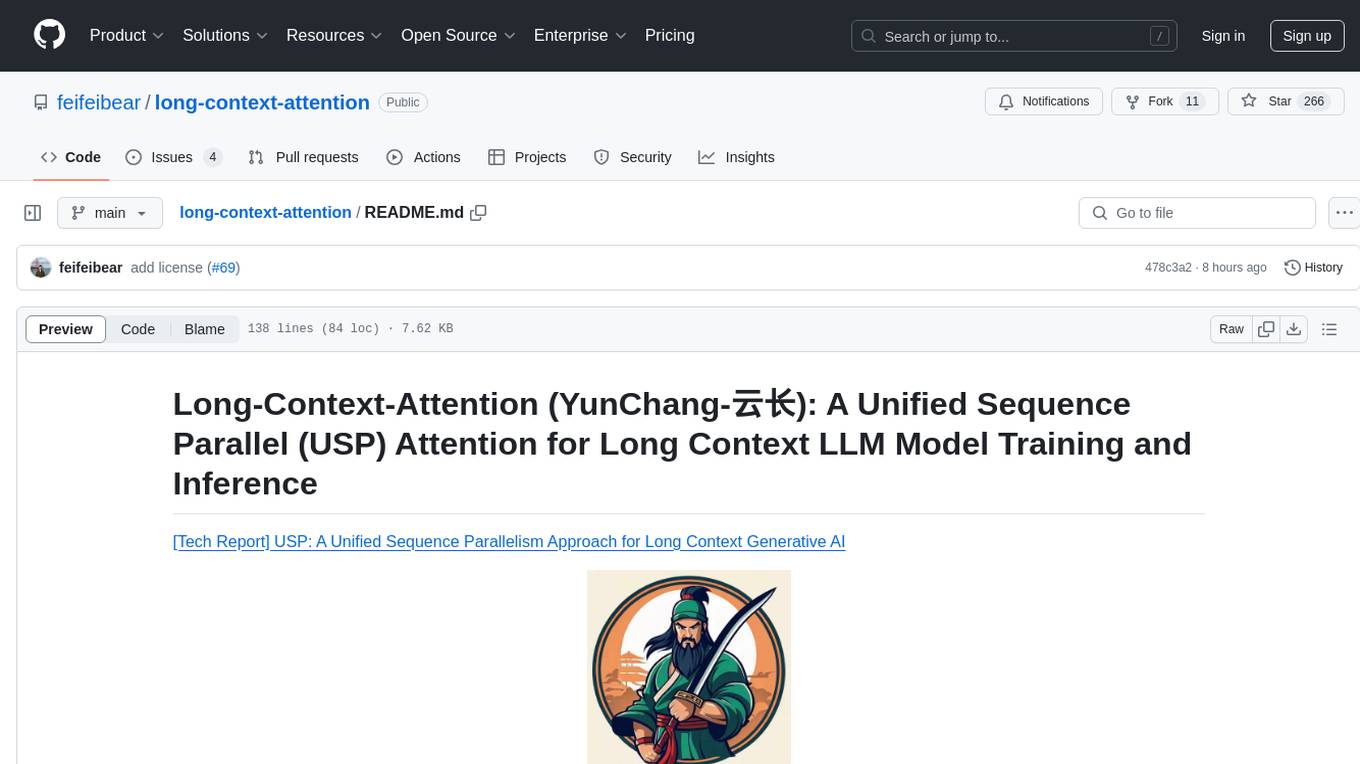
long-context-attention
Long-Context-Attention (YunChang) is a unified sequence parallel approach that combines the strengths of DeepSpeed-Ulysses-Attention and Ring-Attention to provide a versatile and high-performance solution for long context LLM model training and inference. It addresses the limitations of both methods by offering no limitation on the number of heads, compatibility with advanced parallel strategies, and enhanced performance benchmarks. The tool is verified in Megatron-LM and offers best practices for 4D parallelism, making it suitable for various attention mechanisms and parallel computing advancements.

marlin
Marlin is a highly optimized FP16xINT4 matmul kernel designed for large language model (LLM) inference, offering close to ideal speedups up to batchsizes of 16-32 tokens. It is suitable for larger-scale serving, speculative decoding, and advanced multi-inference schemes like CoT-Majority. Marlin achieves optimal performance by utilizing various techniques and optimizations to fully leverage GPU resources, ensuring efficient computation and memory management.
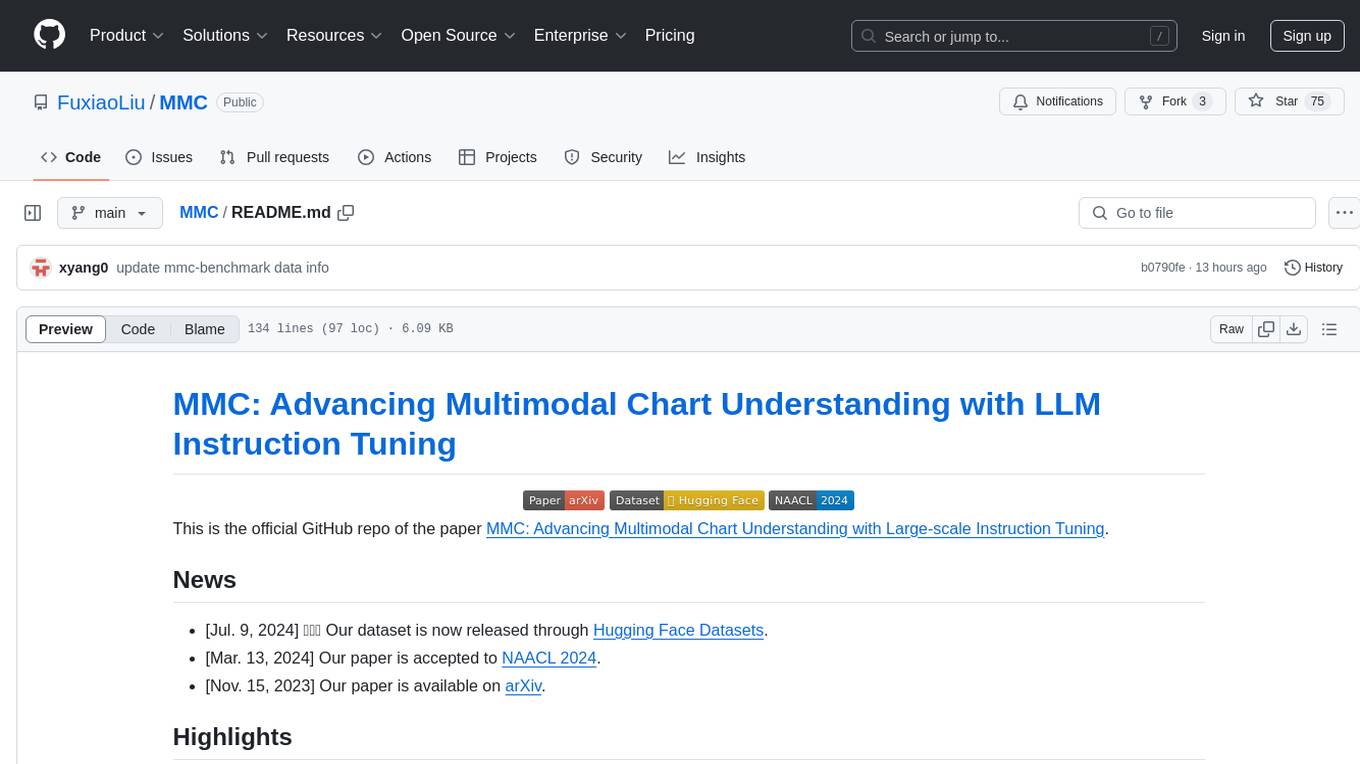
MMC
This repository, MMC, focuses on advancing multimodal chart understanding through large-scale instruction tuning. It introduces a dataset supporting various tasks and chart types, a benchmark for evaluating reasoning capabilities over charts, and an assistant achieving state-of-the-art performance on chart QA benchmarks. The repository provides data for chart-text alignment, benchmarking, and instruction tuning, along with existing datasets used in experiments. Additionally, it offers a Gradio demo for the MMCA model.
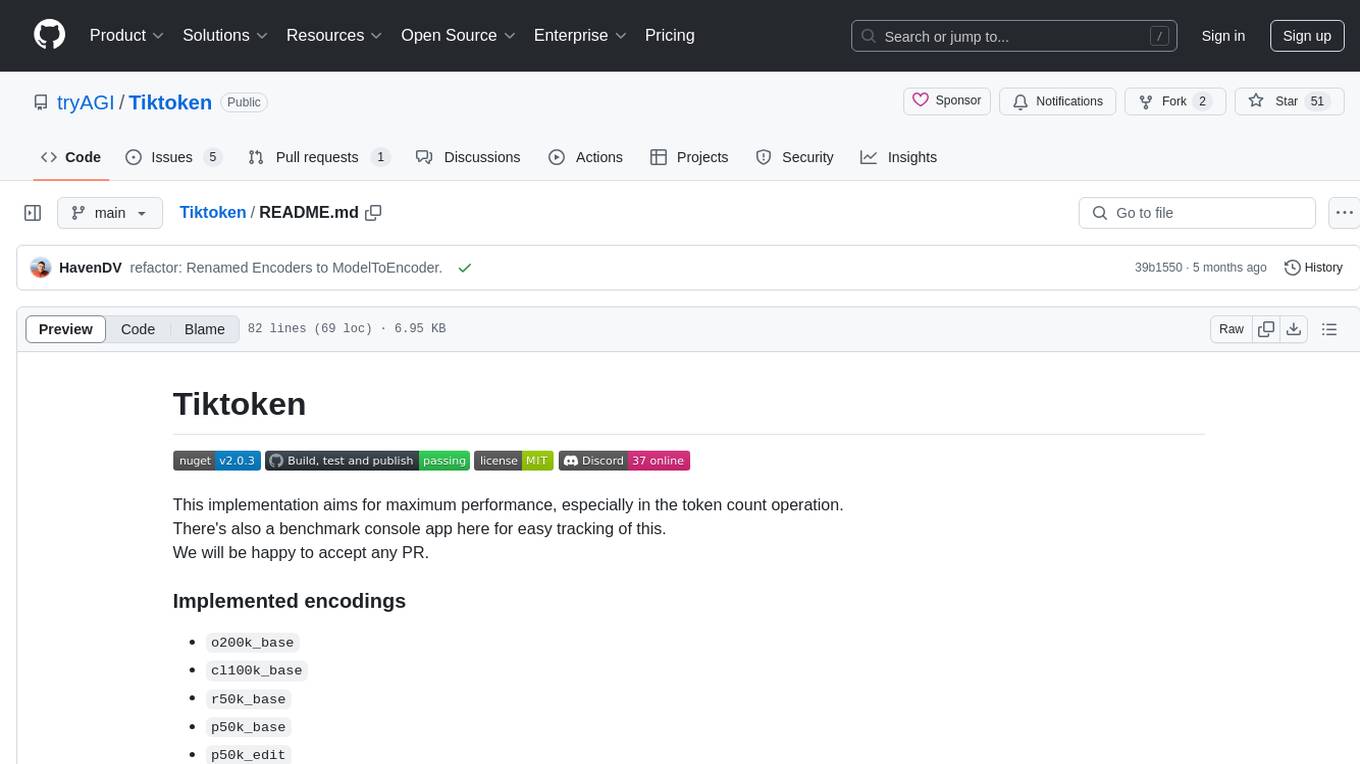
Tiktoken
Tiktoken is a high-performance implementation focused on token count operations. It provides various encodings like o200k_base, cl100k_base, r50k_base, p50k_base, and p50k_edit. Users can easily encode and decode text using the provided API. The repository also includes a benchmark console app for performance tracking. Contributions in the form of PRs are welcome.

ppl.llm.serving
ppl.llm.serving is a serving component for Large Language Models (LLMs) within the PPL.LLM system. It provides a server based on gRPC and supports inference for LLaMA. The repository includes instructions for prerequisites, quick start guide, model exporting, server setup, client usage, benchmarking, and offline inference. Users can refer to the LLaMA Guide for more details on using this serving component.
For similar jobs
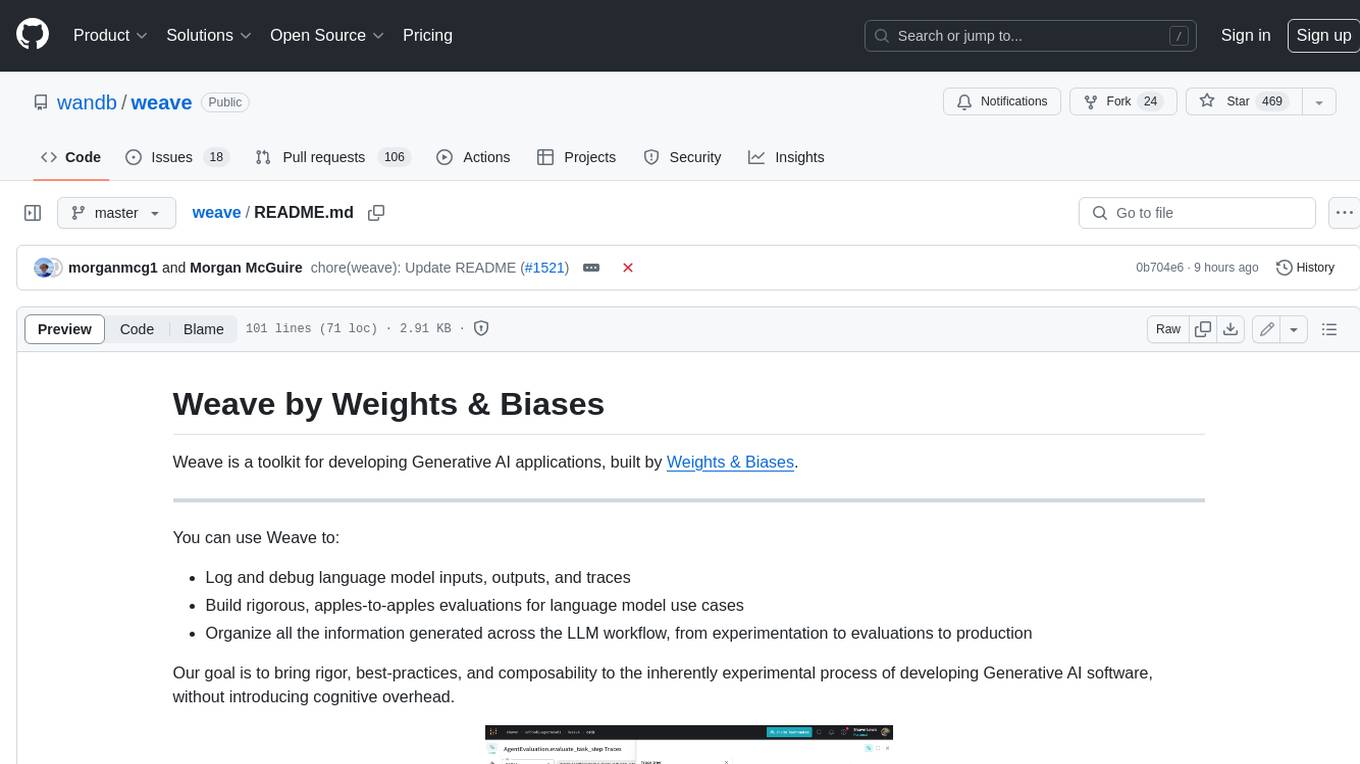
weave
Weave is a toolkit for developing Generative AI applications, built by Weights & Biases. With Weave, you can log and debug language model inputs, outputs, and traces; build rigorous, apples-to-apples evaluations for language model use cases; and organize all the information generated across the LLM workflow, from experimentation to evaluations to production. Weave aims to bring rigor, best-practices, and composability to the inherently experimental process of developing Generative AI software, without introducing cognitive overhead.
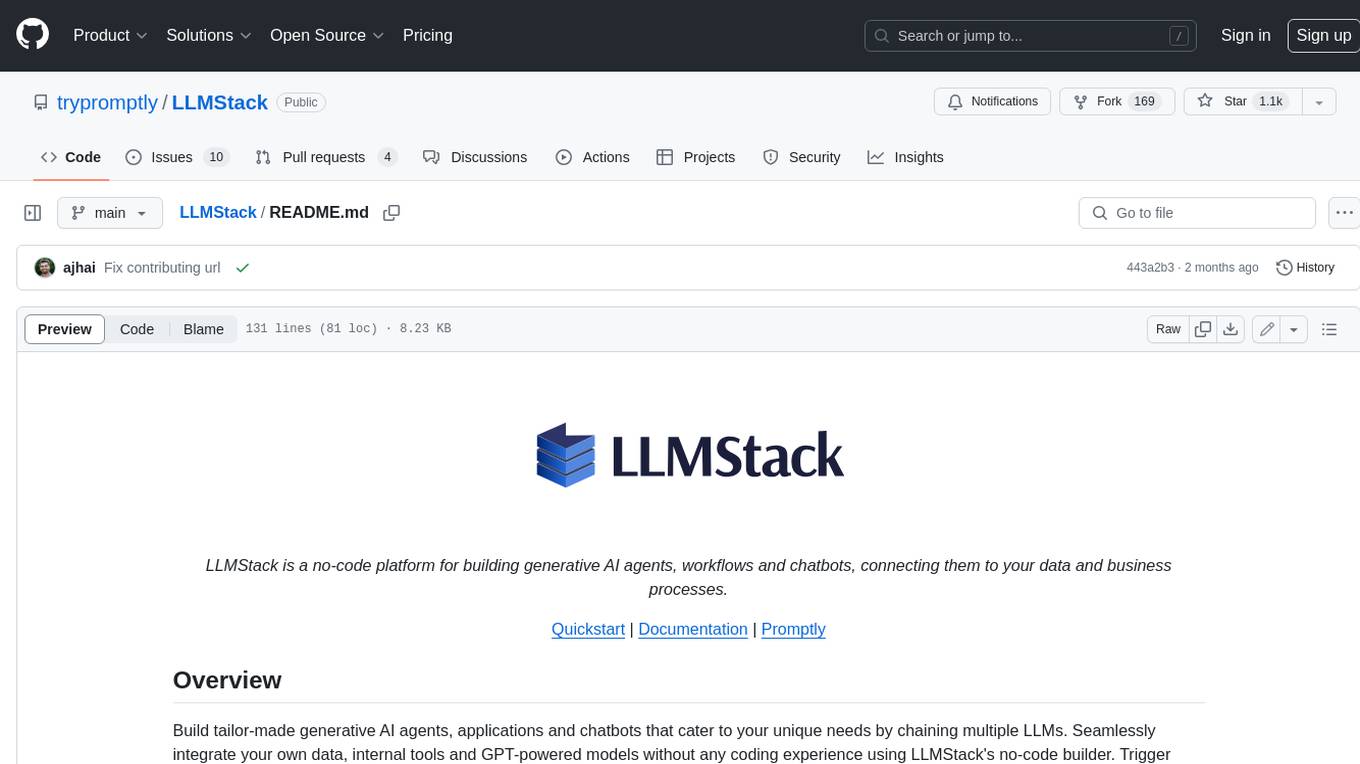
LLMStack
LLMStack is a no-code platform for building generative AI agents, workflows, and chatbots. It allows users to connect their own data, internal tools, and GPT-powered models without any coding experience. LLMStack can be deployed to the cloud or on-premise and can be accessed via HTTP API or triggered from Slack or Discord.
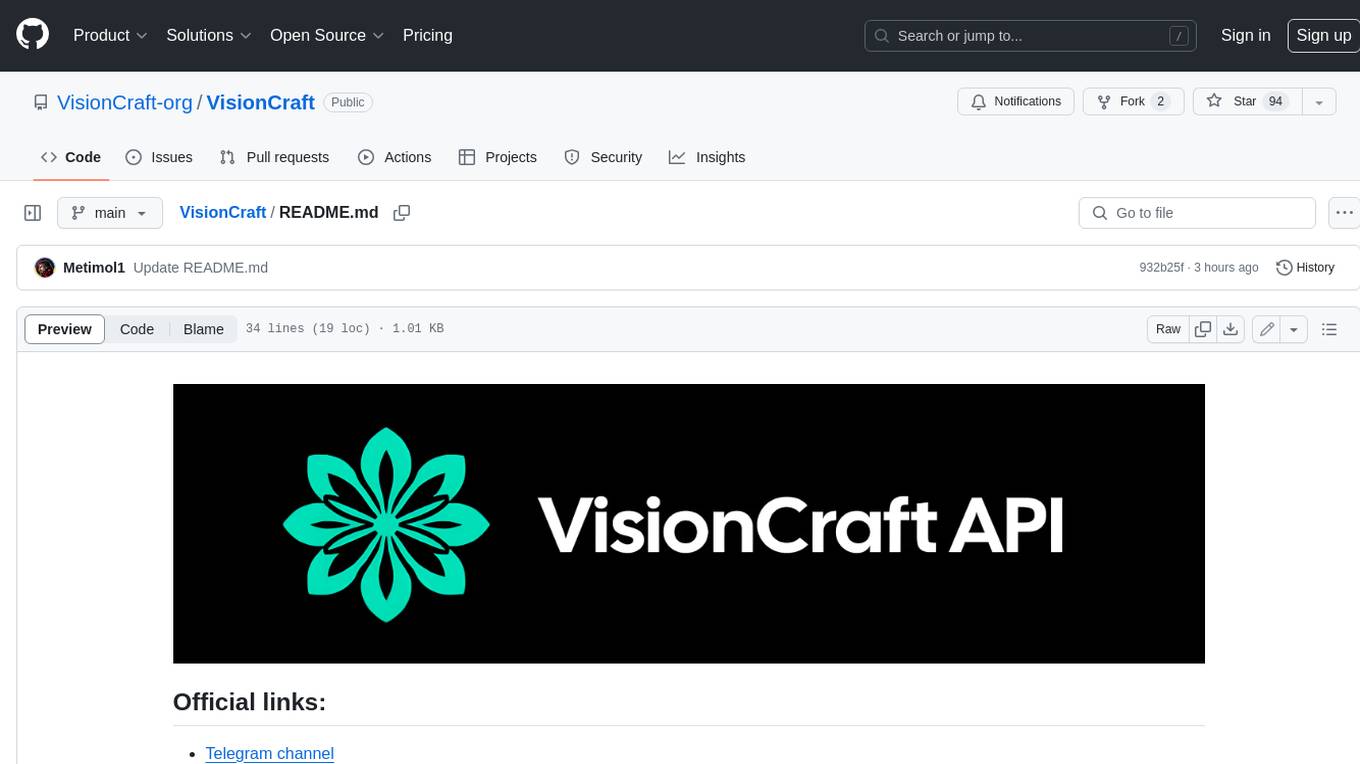
VisionCraft
The VisionCraft API is a free API for using over 100 different AI models. From images to sound.

kaito
Kaito is an operator that automates the AI/ML inference model deployment in a Kubernetes cluster. It manages large model files using container images, avoids tuning deployment parameters to fit GPU hardware by providing preset configurations, auto-provisions GPU nodes based on model requirements, and hosts large model images in the public Microsoft Container Registry (MCR) if the license allows. Using Kaito, the workflow of onboarding large AI inference models in Kubernetes is largely simplified.
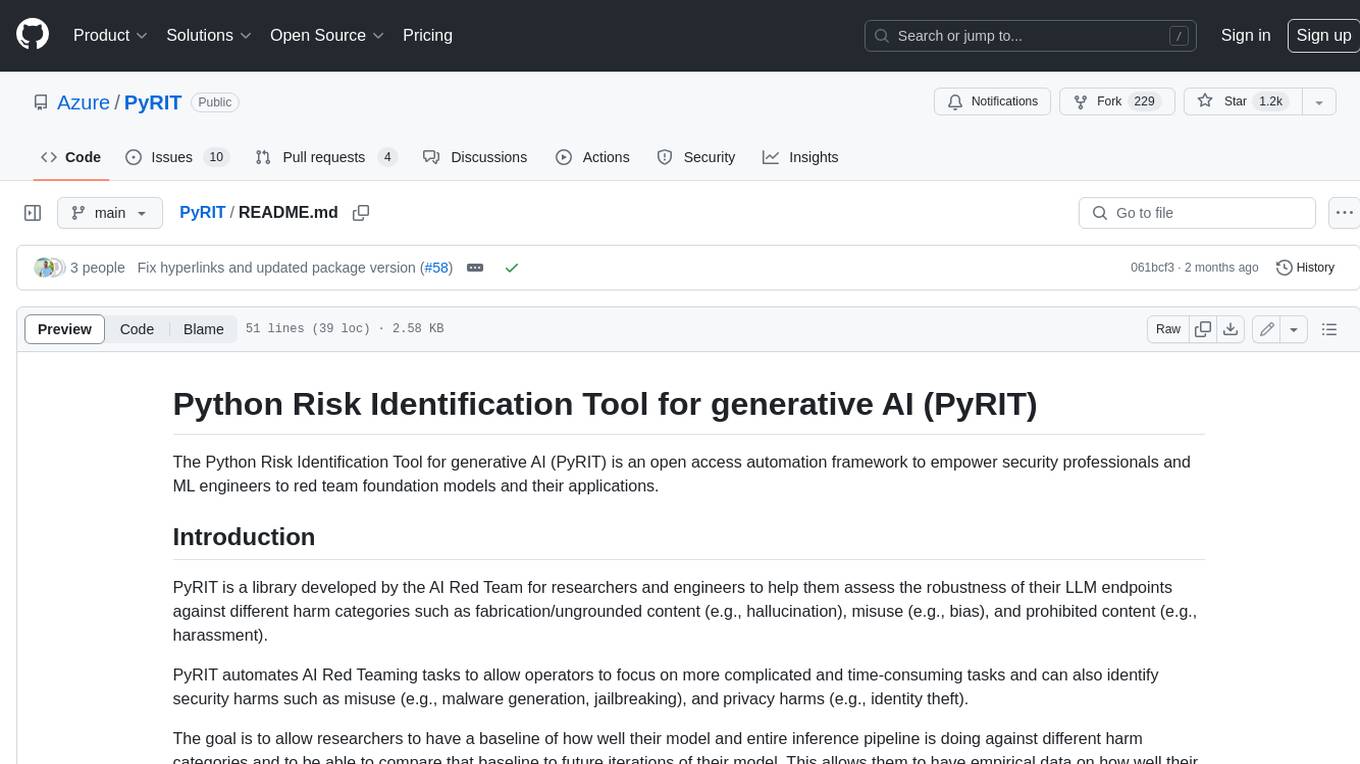
PyRIT
PyRIT is an open access automation framework designed to empower security professionals and ML engineers to red team foundation models and their applications. It automates AI Red Teaming tasks to allow operators to focus on more complicated and time-consuming tasks and can also identify security harms such as misuse (e.g., malware generation, jailbreaking), and privacy harms (e.g., identity theft). The goal is to allow researchers to have a baseline of how well their model and entire inference pipeline is doing against different harm categories and to be able to compare that baseline to future iterations of their model. This allows them to have empirical data on how well their model is doing today, and detect any degradation of performance based on future improvements.
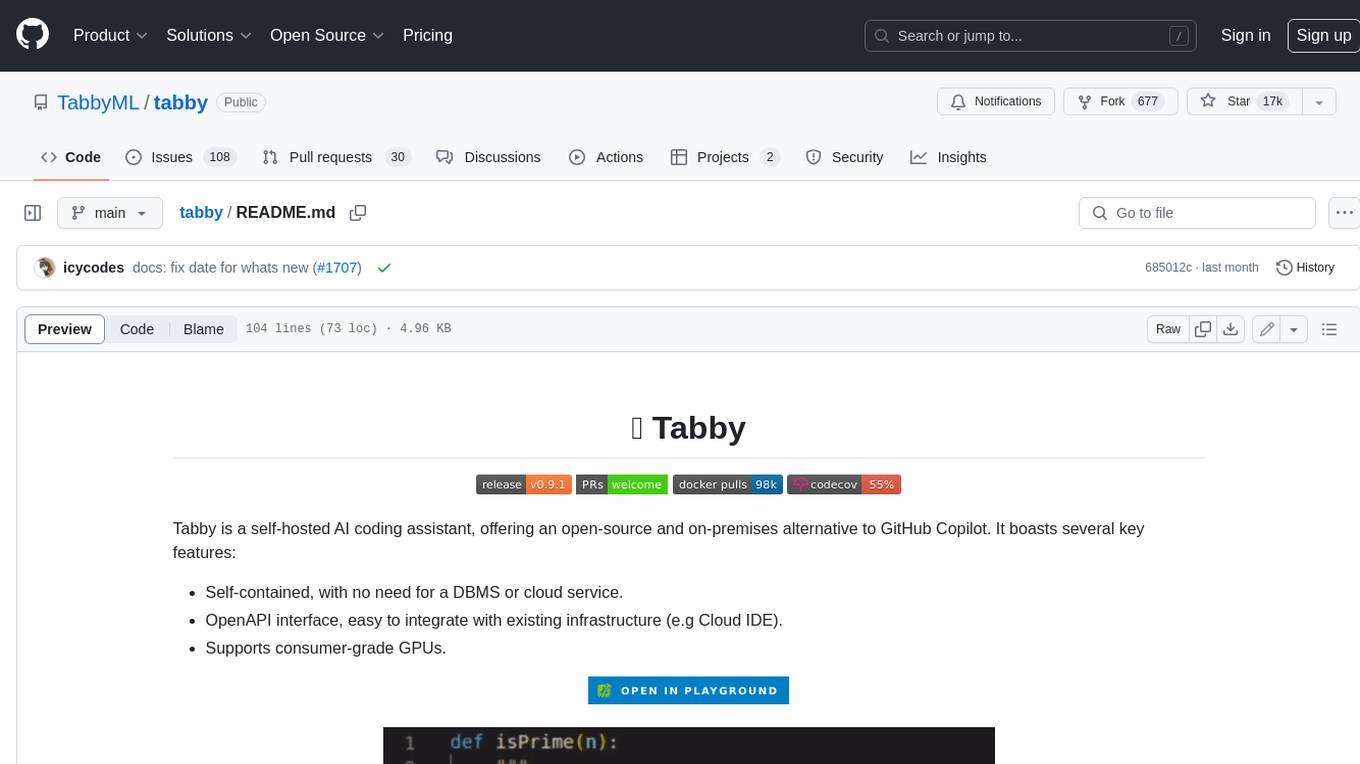
tabby
Tabby is a self-hosted AI coding assistant, offering an open-source and on-premises alternative to GitHub Copilot. It boasts several key features: * Self-contained, with no need for a DBMS or cloud service. * OpenAPI interface, easy to integrate with existing infrastructure (e.g Cloud IDE). * Supports consumer-grade GPUs.
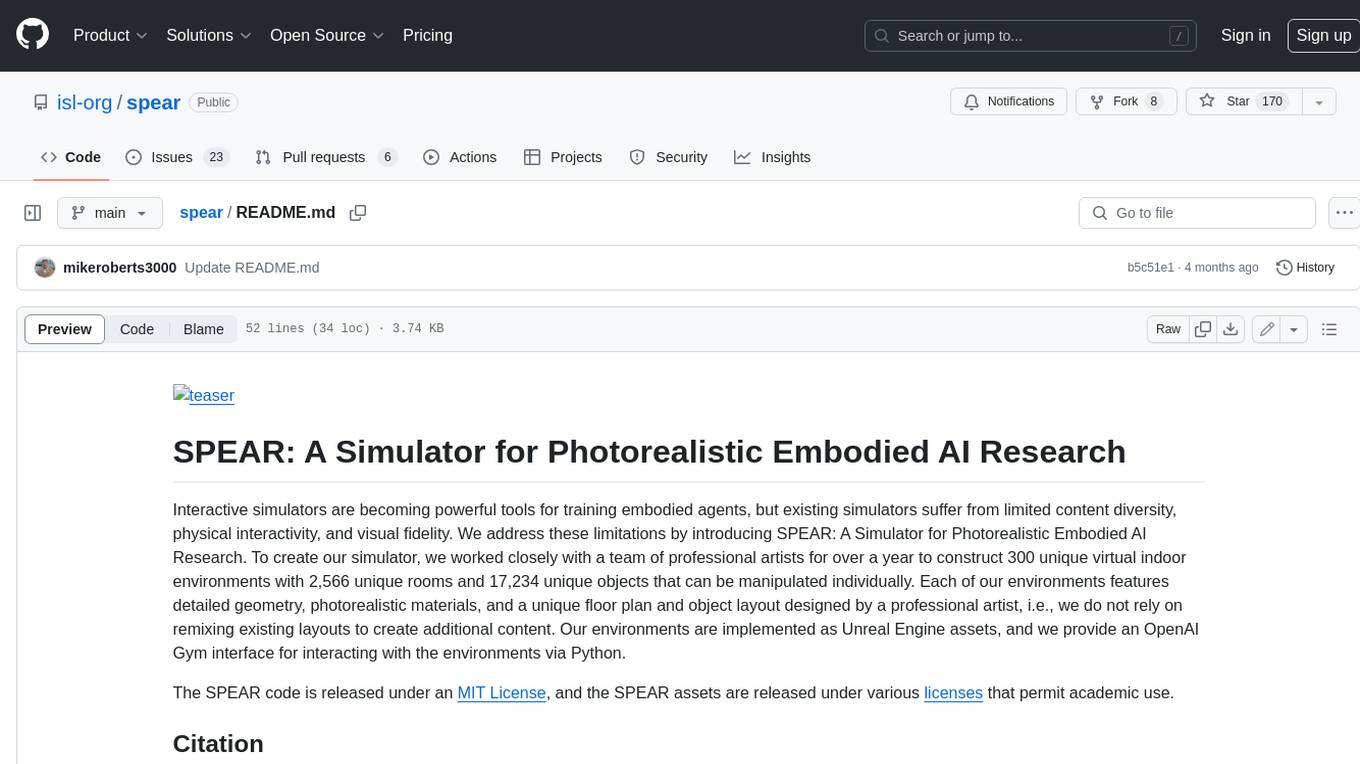
spear
SPEAR (Simulator for Photorealistic Embodied AI Research) is a powerful tool for training embodied agents. It features 300 unique virtual indoor environments with 2,566 unique rooms and 17,234 unique objects that can be manipulated individually. Each environment is designed by a professional artist and features detailed geometry, photorealistic materials, and a unique floor plan and object layout. SPEAR is implemented as Unreal Engine assets and provides an OpenAI Gym interface for interacting with the environments via Python.
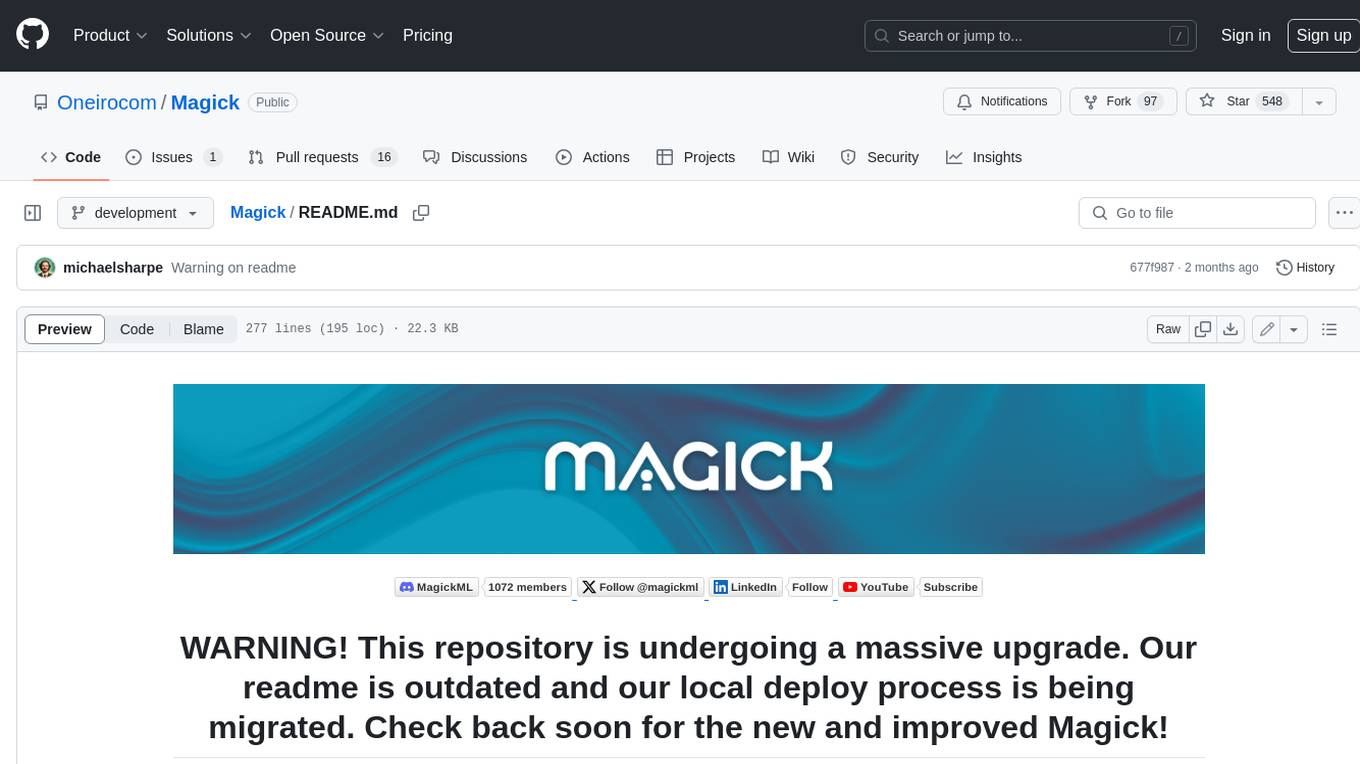
Magick
Magick is a groundbreaking visual AIDE (Artificial Intelligence Development Environment) for no-code data pipelines and multimodal agents. Magick can connect to other services and comes with nodes and templates well-suited for intelligent agents, chatbots, complex reasoning systems and realistic characters.

